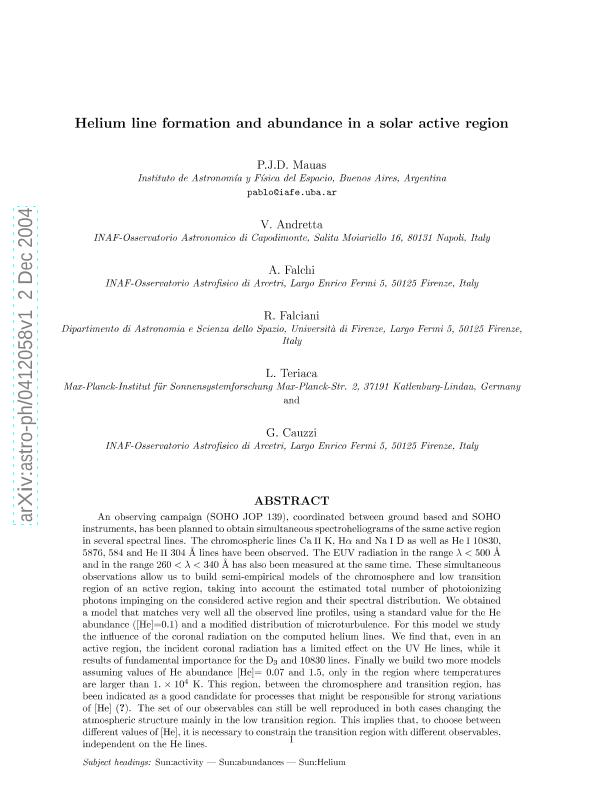Mostrar el registro sencillo del ítem
dc.contributor.author
Mauas, Pablo Jacobo David

dc.contributor.author
Andretta, V.
dc.contributor.author
Falchi, A.
dc.contributor.author
Falciani, R.
dc.contributor.author
Teriaca, L.
dc.contributor.author
Cauzzi, G.
dc.date.available
2017-07-20T19:19:57Z
dc.date.issued
2005-12
dc.identifier.citation
Mauas, Pablo Jacobo David; Andretta, V.; Falchi, A.; Falciani, R.; Teriaca, L.; et al.; Helium Line Formation and Abundance in a Solar Active Region; IOP Publishing; Astrophysical Journal; 619; 1; 12-2005; 604-612
dc.identifier.issn
0004-637X
dc.identifier.uri
http://hdl.handle.net/11336/21019
dc.description.abstract
An observing campaign (SOHO JOP 139), coordinated between ground-based and Solar and Heliospheric Observatory (SOHO) instruments, has been planned to obtain simultaneous spectroheliograms of the same active region in several spectral lines. The chromospheric lines Ca ii K, H , and Na i D, as well as He i 10830, 5876, 584, and He ii 304 8 lines have been observed. The EUV radiation in the range k < 500 8 and in the range 260 < k < 340 8 has also been measured at the same time. These simultaneous observations allow us to build semiempirical models of the chromosphere and low transition region of an active region, taking into account the estimated total number of photoionizing photons impinging on the target active region and their spectral distribution. We obtained a model that matches very well all the observed line profiles, using a standard value for the He
abundance (½He ¼ 0:1) and a modified distribution of microturbulence. For this model we study the influence of the coronal radiation on the computed helium lines. We find that, even in an active region, the incident coronal radiation has a limited effect on the UV He lines, while it is of fundamental importance for the D3 and 10830 8 lines. Finally, we build two more models, assuming values of He abundance ½He ¼ 0:07 and 1.5, only in the region where temperatures are >1 ; 104 K. This region, between the chromosphere and transition region, has been indicated as a good candidate for processes that might be responsible for strong variations of [He]. The set of our observables can still be well reproduced in both cases, changing the atmospheric structure mainly in the low transition region. This
implies that, to choose between different values of [He], it is necessary to constrain the transition region with different observables, independent of the He lines.
dc.format
application/pdf
dc.language.iso
eng
dc.publisher
IOP Publishing

dc.rights
info:eu-repo/semantics/openAccess
dc.rights.uri
https://creativecommons.org/licenses/by-nc-sa/2.5/ar/
dc.subject
Astrophysics
dc.subject.classification
Astronomía

dc.subject.classification
Ciencias Físicas

dc.subject.classification
CIENCIAS NATURALES Y EXACTAS

dc.title
Helium Line Formation and Abundance in a Solar Active Region
dc.type
info:eu-repo/semantics/article
dc.type
info:ar-repo/semantics/artículo
dc.type
info:eu-repo/semantics/publishedVersion
dc.date.updated
2017-07-20T13:07:58Z
dc.journal.volume
619
dc.journal.number
1
dc.journal.pagination
604-612
dc.journal.pais
Reino Unido

dc.journal.ciudad
Londres
dc.description.fil
Fil: Mauas, Pablo Jacobo David. Consejo Nacional de Investigaciónes Científicas y Técnicas. Oficina de Coordinación Administrativa Ciudad Universitaria. Instituto de Astronomía y Física del Espacio. - Universidad de Buenos Aires. Facultad de Ciencias Exactas y Naturales. Instituto de Astronomía y Física del Espacio; Argentina
dc.description.fil
Fil: Andretta, V.. Osservatorio Astronomico di Capodimonte; Italia
dc.description.fil
Fil: Falchi, A.. Osservatorio Astrofisico di Arcetri; Italia
dc.description.fil
Fil: Falciani, R.. Universita Degli Studi Di Firenze; Italia
dc.description.fil
Fil: Teriaca, L.. Max-Planck-Institut fur Sonnensystemforschung; Alemania
dc.description.fil
Fil: Cauzzi, G.. Osservatorio Astrofisico di Arcetri; Italia
dc.journal.title
Astrophysical Journal

dc.relation.alternativeid
info:eu-repo/semantics/altIdentifier/url/http://iopscience.iop.org/article/10.1086/426428
dc.relation.alternativeid
info:eu-repo/semantics/altIdentifier/url/https://arxiv.org/abs/astro-ph/0412058
Archivos asociados
